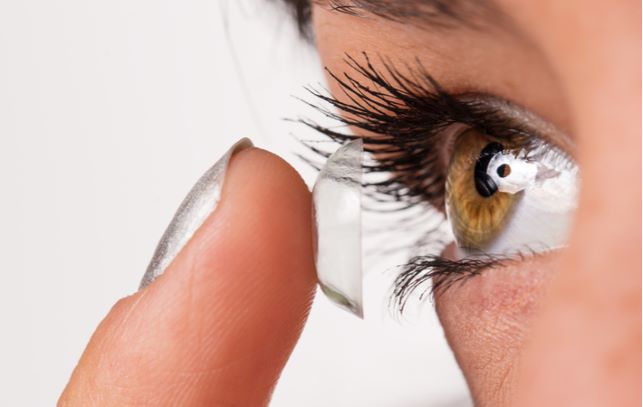When looking for contact lenses, there are many to choose from and several considerations to make. There’s lens material, fit, and type, among other options. Your optometrist may recommend specialty contacts to you, such as scleral or hybrid lenses.
When choosing between these specialty lenses, what’s the difference between them? Continue reading to learn more about scleral and hybrid lenses, including what they are, their benefits, and how they differ.
Types of Contact Lenses
There are many types of contact lenses available today to treat refractive errors, such as:
These thin plastic lenses rest on your eye and help you see clearly. Depending on your needs, there are extended wear and daily disposable contacts. Contact lenses are typically soft or rigid gas permeable lenses.
Soft contact lenses consist of soft and flexible plastic designed to allow oxygen to reach the cornea. They’re easier to adjust to and comfortable, making them ideal for new contact wearers.
Rigid gas permeable contact lenses are a more durable option. They’re resistant to deposit buildup and provide a crisp and clear vision. While these lenses are longer lasting and easier to handle, they aren’t as comfortable as soft contacts.
Specialty Contacts
If you have certain eye conditions, you may require specialty contact lenses. Astigmatism and dry eyes can make standard contact lenses difficult to wear. Today, many optometrists offer specialty contacts like toric, hybrid, and scleral lenses to address these issues.
Your eye doctor may recommend scleral or hybrid lenses if you need specialty contacts. There are some differences between these options, so let’s learn more about them.
What Are Scleral Contact Lenses
Scleral contact lenses are beneficial for many different eye conditions. Unlike other contacts, they cover your entire corneal surface. They rest on the white of your eye, known as the sclera.
Compared to soft contacts, scleral lenses have greater durability, easier handling, and provide sharper vision. Scleral lenses are beneficial for several eye conditions, such as:
- Astigmatism
- Keratoconus
- Dry eyes
- Corneal irregularities
- Graft versus host disease
- Stevens-Johnson syndrome
The design of these lenses allows them to change an irregular cornea into a smooth optical surface. Scleral lenses are typically more comfortable than other lens types. Another benefit of scleral lenses are their benefits for dry eye sufferers.
Dry eye disease can make contact lenses difficult to wear. Scleral lenses help because they feature a sizable space between the back of the lens and cornea. This space acts as a tear reservoir, helping keep the eye’s surface moist.
Types of Scleral Lenses
There are different types of scleral lenses. They differ in their overall size and where they make contact with your eye.
Types of scleral contact lenses include:
- Full scleral lenses: The largest available, these lenses provide the most space between the back of the lens & the cornea
- Corneo-scleral & semi-scleral lenses: These are larger than standard rigid gas permeable lenses & rest between the cornea & sclera
- Mini-scleral lenses: These lenses vault over the cornea and rest on the anterior sclera
Scleral lenses are a good choice if you have one of these listed eye conditions, but what about hybrid contacts? What are they, and how do they work?
What Are Hybrid Contact Lenses
Hybrid contact lenses are the “best of both worlds” of soft and rigid gas permeable contact lenses. They feature a rigid gas permeable center to help you see clearly, and a soft outer ring surrounds the lens. This soft outer ring provides comfortable wear without compromising clear vision.
A harder lens provides better vision because it masks corneal distortions. However, it’s typically less comfortable to wear. Hybrid contact lenses have the benefits of both contact lens materials.
Hybrid contacts can be beneficial for several eye conditions, such as:
- Astigmatism
- Corneal irregularities
- Presbyopia
- Keratoconus
- Corneal transplant recovery
Both contacts offer effective and comfortable vision, making it hard to decide which is best for your needs. Hybrid and scleral contact lenses have some similarities, but how do they differ?
What is the Difference Between Scleral & Hybrid Contact Lenses?
There are a couple of differences between scleral and hybrid contact lenses.
Scleral lenses tend to be larger than hybrid lenses due to them resting on the sclera. Because hybrid lenses don’t vault over the cornea like scleral contacts, they lack a fluid reservoir. Additionally, scleral lenses come in multiple variations.
While hybrid contact lenses can provide excellent vision, they may be more challenging to fit. If you’re looking for the best contact lenses for your needs, speaking with your optometrist can help.

Book a Contact Lens Exam & Fitting
There are many similarities between scleral and hybrid contacts, but they serve different purposes. There’s no definite better option between them—the best choice for you depends on your unique needs. Your optometrist can determine the most effective contact lenses for you during a contact lens exam and fitting.
Contact your eye doctor if you need new contacts or are interested in specialty options.



